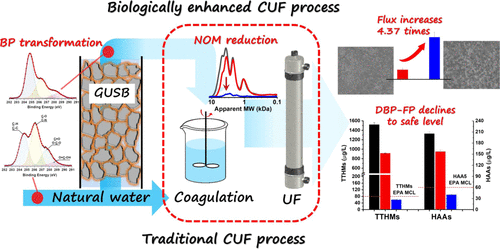当前位置:
X-MOL 学术
›
ACS ES&T Eng.
›
论文详情
Our official English website, www.x-mol.net, welcomes your
feedback! (Note: you will need to create a separate account there.)
Biologically Enhanced Coagulation–Ultrafiltration Process for Healthy Water Production with Low Fouling Propensity
ACS ES&T Engineering ( IF 7.4 ) Pub Date : 2021-11-19 , DOI: 10.1021/acsestengg.1c00279 Lei Xu 1 , Shuo Li 1 , Nigel J. D. Graham 2 , Wenzheng Yu 1
ACS ES&T Engineering ( IF 7.4 ) Pub Date : 2021-11-19 , DOI: 10.1021/acsestengg.1c00279 Lei Xu 1 , Shuo Li 1 , Nigel J. D. Graham 2 , Wenzheng Yu 1
Affiliation

|
Coagulation combined with ultrafiltration (UF) is an effective drinking water treatment process. However, inefficient removal of natural organic matter (NOM) and membrane fouling problems, especially those initiated by the adhesion of biopolymers, greatly restrict the practical application of the UF process. Here, we investigated a biologically enhanced coagulation–ultrafiltration (CUF) process treating samples of a natural surface water, which demonstrated a superior NOM removal and antifouling performance. The membrane flux (under 1.0 bar constant pressure) of the biologically enhanced CUF [using polyaluminum chloride (PACl)] process scheme was approximately 4.4 and 8.4 times higher than that of a conventional CUF and direct UF process, respectively, and PACl was found to perform better than AlCl3. Characterization of the NOM showed that the biological pretreatment combined with the coagulation process significantly contributed to the reduction of hydrophobicity, aromaticity, and molecular weight of the dissolved organics. Analyses of biopolymers showed that the combined process can remove over 99% of the biopolymers (represented by proteins and polysaccharides), which are considered to be the main cause of membrane fouling. Results of X-ray photoelectron spectroscopy and FTIR analyses further elucidated the transformation and reduction of biopolymers during the combined process. With respect to the disinfection byproduct formation potential (DBP-FP), the results showed that the conventional CUF process had a limited impact on the DBP-FP, while the biologically enhanced CUF process had a substantial impact consistent with meeting the current EPA DBP standards. Overall, this study has highlighted the potential advantages of using a biologically enhanced CUF process for producing higher quality drinking water with a simultaneous low membrane fouling propensity.
中文翻译:

生物强化混凝-超滤工艺可实现低结垢倾向的健康水生产
混凝结合超滤 (UF) 是一种有效的饮用水处理工艺。然而,天然有机物(NOM)去除效率低下和膜污染问题,特别是由生物聚合物粘附引发的问题,极大地限制了UF工艺的实际应用。在这里,我们研究了一种处理天然地表水样品的生物增强混凝-超滤 (CUF) 工艺,该工艺表现出优异的 NOM 去除和防污性能。生物增强 CUF [使用聚合氯化铝 (PACl)] 工艺方案的膜通量(在 1.0 bar 恒压下)分别比传统 CUF 和直接 UF 工艺高约 4.4 倍和 8.4 倍,发现 PACl性能优于 AlCl 3. NOM 的表征表明,生物预处理与混凝过程相结合,显着降低了溶解有机物的疏水性、芳香性和分子量。对生物聚合物的分析表明,联合工艺可以去除 99% 以上的生物聚合物(以蛋白质和多糖为代表),这被认为是造成膜污染的主要原因。X 射线光电子能谱和 FTIR 分析的结果进一步阐明了组合过程中生物聚合物的转化和还原。关于消毒副产物形成潜力(DBP-FP),结果表明传统的 CUF 工艺对 DBP-FP 的影响有限,而生物增强的 CUF 工艺具有符合当前 EPA DBP 标准的实质性影响。总体而言,这项研究强调了使用生物增强型 CUF 工艺生产更高质量的饮用水并同时降低膜污染倾向的潜在优势。
更新日期:2022-01-14
中文翻译:

生物强化混凝-超滤工艺可实现低结垢倾向的健康水生产
混凝结合超滤 (UF) 是一种有效的饮用水处理工艺。然而,天然有机物(NOM)去除效率低下和膜污染问题,特别是由生物聚合物粘附引发的问题,极大地限制了UF工艺的实际应用。在这里,我们研究了一种处理天然地表水样品的生物增强混凝-超滤 (CUF) 工艺,该工艺表现出优异的 NOM 去除和防污性能。生物增强 CUF [使用聚合氯化铝 (PACl)] 工艺方案的膜通量(在 1.0 bar 恒压下)分别比传统 CUF 和直接 UF 工艺高约 4.4 倍和 8.4 倍,发现 PACl性能优于 AlCl 3. NOM 的表征表明,生物预处理与混凝过程相结合,显着降低了溶解有机物的疏水性、芳香性和分子量。对生物聚合物的分析表明,联合工艺可以去除 99% 以上的生物聚合物(以蛋白质和多糖为代表),这被认为是造成膜污染的主要原因。X 射线光电子能谱和 FTIR 分析的结果进一步阐明了组合过程中生物聚合物的转化和还原。关于消毒副产物形成潜力(DBP-FP),结果表明传统的 CUF 工艺对 DBP-FP 的影响有限,而生物增强的 CUF 工艺具有符合当前 EPA DBP 标准的实质性影响。总体而言,这项研究强调了使用生物增强型 CUF 工艺生产更高质量的饮用水并同时降低膜污染倾向的潜在优势。











































 京公网安备 11010802027423号
京公网安备 11010802027423号